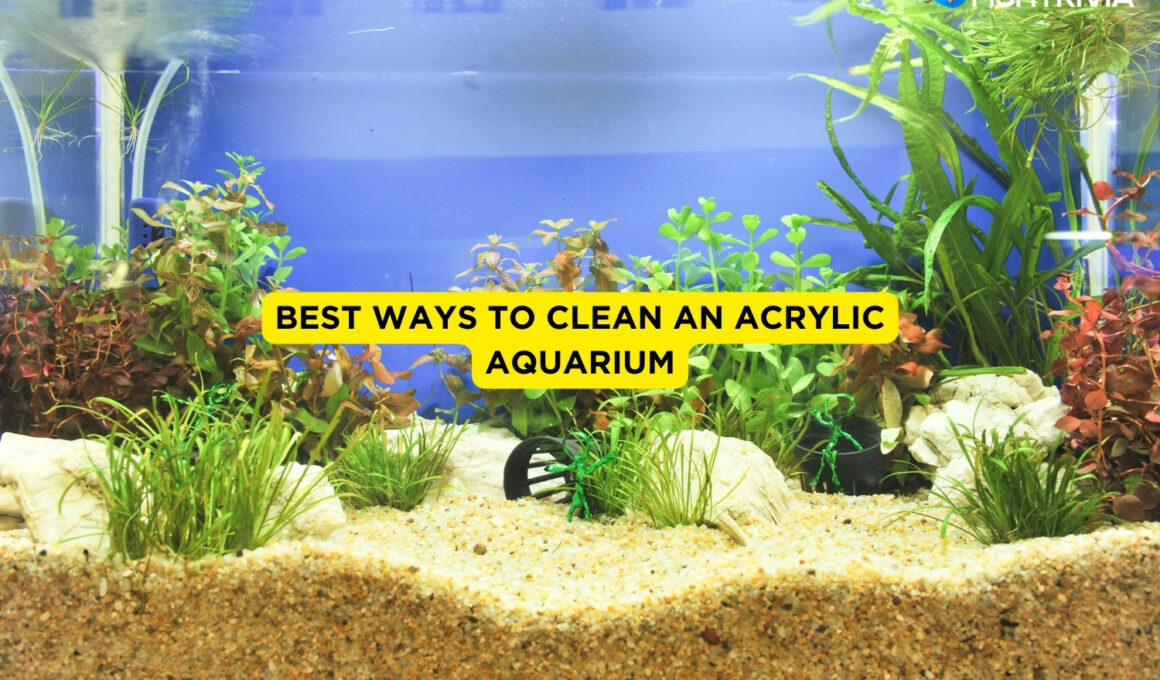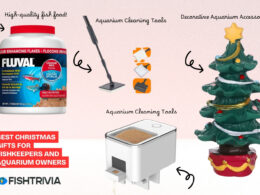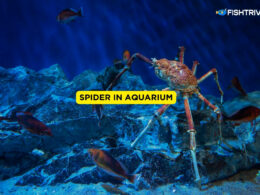In this article Show
Aquariums, no matter where you keep them, are attractive decorative objects. In the late 1800s, the tradition of aquarium keeping occurred. It was very hard. These old aquariums typically only had one foot.
Glass, metal, or wood on the other three sides. Nowadays, acrylic aquariums are pretty common for good reasons.
The nice thing about acrylic is that it behaves like outside glass. You love to own an acrylic tank very much. Acrylic, for one thing, is thicker and more flexible than glass, which means it can not quickly shake or spill.
It also weighs less than glass, making it easy to collect and carry about. And you can’t beat such a clear-sighted vision, of course! Moreover, in architecture than glass, acrylic has more versatility.
The fish would not be easily visible if the glass walls are dusty and spotted and the whole target is missed. The glass walls must then be washed from the interior and exterior periodically.
It might seem a challenging chore to clean your acrylic aquarium, but the work can be healthy for the tank and quick on you with the right equipment. With the aid of these realistic guides, scratches can be avoided to guide you.
The cleaning of acrylic aquariums is a little difficult because it is prone to scratching. Read the article for tips on how to disinfect and scratch-free your acrylic aquariums.
Also worth reading;
- The Best Fishes To Keep With Shrimps In A Freshwater Tank
- How Long Should You Leave Aquarium Lights On?
- Can You Grow Aquarium Plants In Gravel? (Which Is The Best)
- Cleaning Fish Tank With Vinegar: Step By Step Guides
- How to Clean Fish Tank Gravel: (With Vacuum & Without Vacuum)
Best Ways to Clean An Acrylic Aquarium
Acrylic is shaped easily and shapes in nearly any shape-and some can not be identified. Acrylic also seems less to blur stuff under a gradient. Acrylic aquariums have a very large variety of forms-not just rectangular-owing to these two reasons.
1. Clean the Debris
There is nothing like a grain of sand that is threatening the walls of the acrylic aquaria. A small particle trapped between the pad and the wall can cause serious harm.
Remove all sand and waste from the tank walls before washing. To avoid this. And make sure that no ions are mixed as they polish close to the bottom of the tank.
2. Using Water to Clean
Try to use less force than you would if you washed a glass tank while washing an acrylic fish tank. Still aim not to use abrasive fabrics to prevent chemical products, alcohol, and ammonia.
The aquarium will easily look foggy with these fabrics, including scratches. The fact that acrylic is more sensitive than glass does not come out to most owners of fish tanks is that acrylic tanks can not, therefore, be washed the way glass does.
That’s why water is the ideal option. It would surely not harm the surface of your plastic. It does not leave behind traces. Chemicals can have the ability to combat germs, but they probably do more damage to the surface of your tank.
3. Using Clothes to Clean
Only get a smooth piece of soft tissue to make sure that it is wet. You should even take a spray bottle and fill it with clean water if you don’t want to soak the fabric continuously so that the area you need to clean should continue to spray.
Clean the glass on both sides to guarantee that the edges are not missed. Know – don’t scrub too vigorously or leave behind a scratch. With a soft cloth, the glass can be washed clean with warm water. It should be easy to soften the stiff accumulations and then dry them with a waterproof towel.
Any special cleaning solution is required for the synthetic portions. Sprays should not be used for the cleaning of domestic glass because they can infiltrate the tank and damage fish.
4. Use Vaccum to Clean the Gravel
Sand or gravel vacuums are good for washing every fish cistern surface. Be vigilant not to bump the acrylic tank’s sides. Many other objects can be stabbed or lost in the gravel.
Unfed food, dead plants, and waste are included. Ses stuff will make your tank look dirty if you’re not regularly washing your gravel.
You might also check our other in-depth guide about How to Clean Fish Tank Gravel: (With Vacuum & Without a Vacuum)
A vacuum is a healthy choice in your aquarium to clean the gravel. It’s really easy, the best thing about using a vacuum. Only set up it and stroll over the dirt. Even the tiniest stuff, like soil that you could not even see, can be sucked by the vacuum.
Make sure you move your hand carefully while the vacuum is inside the tank. Do not forget that all regions are protected. You can reach the walls of your tank and scratch it if you shift the vacuum too quickly.
5. Use Magnets to Clean
A magnetic glass wall cleaner is a safer way to use. Two magnetic fixtures, each with a washing pad. Inside the tank with the glass touchpad placed the padded part.
On the outside of the tank position the other magnetic part, so that the part is padded. Slide through the glass wall with the outside magnet.
The Mag float water cleaner provides an excellent method for the removal from acrylic surfaces of algae or other waste products. You can wipe the aquarium with these magnets, make sure you clean the aquarium in the first place.
Although these magnets are strong, the influence of water and a clean cloth can not be entirely substituted. Be extremely careful that sand and gravel are not left between the floating and acrylic during cleansing.
6. Use Magic Erasers to Clean
The magic eraser is another instrument for cleaning your acrylic tank. It can be used to purify all surfaces and leave no scratches behind. You can’t think about too much work, so it’s pretty easy to use too.
All you need to do is put some water on the magic eraser, and it can be used and triggered. Using the eraser enough to brush the tank’s sides and corners. You can extract algae, and waste, and give a healthier look to your tank overall.
7. Use Acrylic Fishtank Cleaning Products
Acrylic aquariums, as opposed to glass fish ponds, are very special when washing the equipment used. The soft stuff has too rough the usual sponges and towels of cloth.
Regular cleaners for households such as Windex often leave a stain on their scuff. Then, what does an acrylic watercraft do?
Choose materials made especially for acrylic for safe washing. Use a soft cotton or microfibre fabric and a plastic scraper to give the walls the gentle touch they deserve.
A variety of acrylic-safe liquid polishes are now available on the market, making your outside tank brilliant. In a little, unnoticed area, try every new product even with labeled items for use with acrylic.
8. Use Soft Scrubbing to Clean
Wipe down your acrylic aquarium’s walls is a responsive operation, so don’t clean yourself too vigorously when you hit a hard location. Add friction hazards that inflict bruises or scuffs.
Try to clear harsh caked algae with a plastic scraper. However, don’t scrape the wall at an angle to scuff the tank. Place the scraper flush on the wall and rub the area closely to prevent scratching. In certain cases, you may need a razor blade but treat it carefully.
9. Clean The Outside Wall
The Tank walls are very easy to clean from the outside. The exterior will also have rubber stripes and hard water piles, which need to be properly washed. With a soft cloth, the glass can be washed clean with warm water.
It should be easy to soften the stiff accumulations and then dry them with a waterproof towel. Any special cleaning solution is required for the synthetic portions. Sprays should not be used for the cleaning of domestic glass because they can infiltrate the tank and damage fish.
Glass Aquarium vs Acrylic Aquarium
There are both benefits and drawbacks to glass versus acrylic aquariums. We have invested a lot of time in deciding what kind of customized aquariums we use in the early days of our service.
| Glass Aquariums | Acrylic Aquariums | ||
| Advantages | Disadvantages | Advantages | Disadvantages |
| Scratch-resistant | Comparably heavy | Comparably light | Scratches easily |
| Ridged panels | More limited shapes | Less limited shapes | Prone to fabrication flaws |
| Won’t turn yellow | More difficult fabrication | Less difficult fabrication | Can yellow over time |
| Non-porous | Porous/absorbs chemicals | ||
| Less visible distortion | Greater visual distortion | ||
| MUCH LESS EXPENSIVE! | MUCH MORE EXPENSIVE! | ||
Conclusion
It is a hard job to clean an acrylic tank, but it is not difficult. As long as you are vigilant, you will purify your acrylic tank without giving up scratches as long as you follow the directions above. A professional will instruct you on how to clean your acrylic aquarium.
Cleaning the acrylic fish tank is quick and scratches can be avoided with the proper equipment and experience. Regularly washing your aquarium takes a long time to maintain it in good condition.












